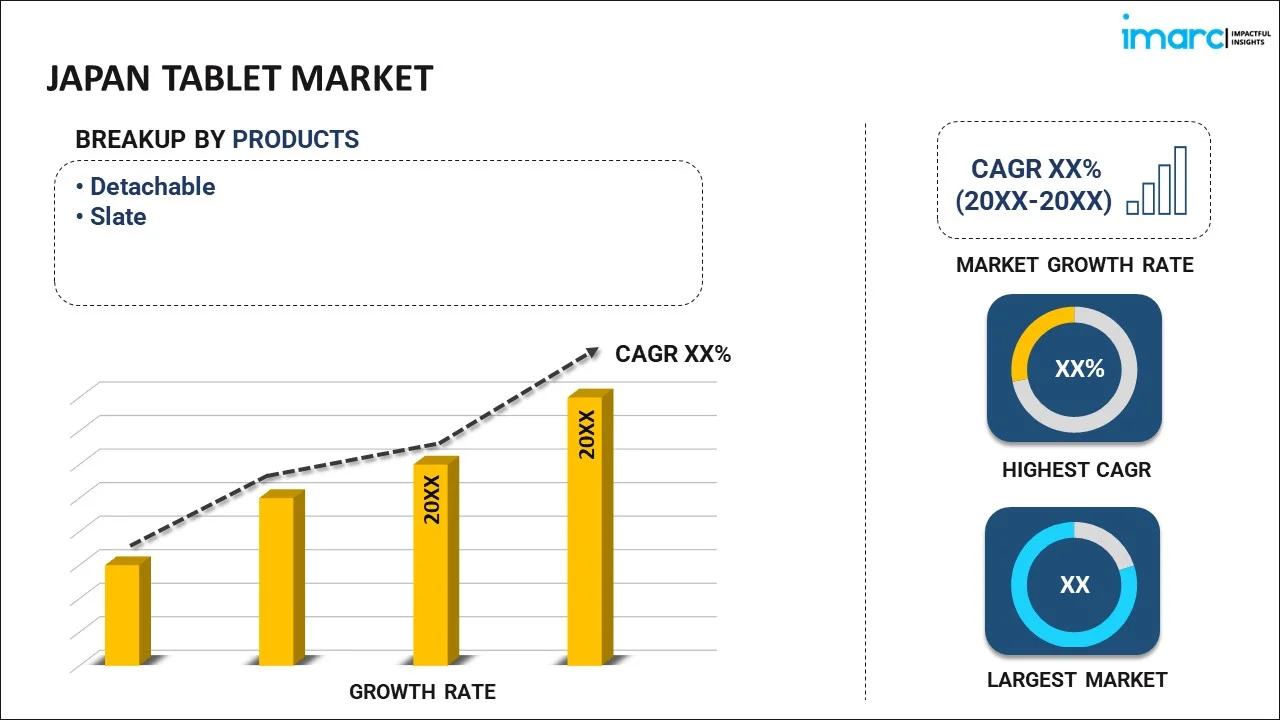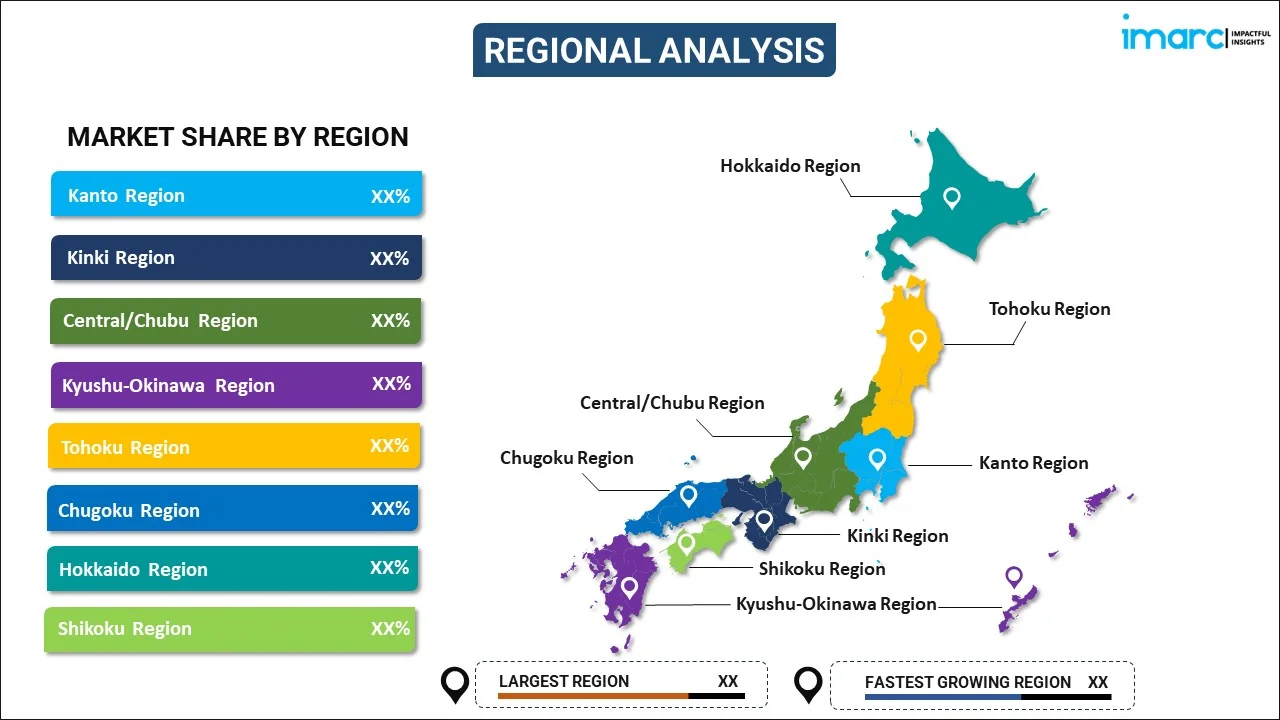
Japan Tablet Market Report by Product (Detachable, Slate), Operating System (Android, IOS, Windows), Screen Size (8’’, 8’’ and Above), End User (Consumer, Commercial), Distribution Channel (Online, Offline), and Region 2025-2033
Market Overview:
The Japan tablet market size reached USD 6.6 Billion in 2024. Looking forward, IMARC Group expects the market to reach USD 9.8 Billion by 2033, exhibiting a growth rate (CAGR) of 4.1% during 2025-2033. The growing adoption of digital lifestyles and the need for seamless connectivity, the rising popularity of streaming services, e-books, digital magazines, and mobile gaming, and improvements in tablet hardware and software are some of the key factors driving the market.
|
Report Attribute
|
Key Statistics
|
|---|---|
|
Base Year
|
2024 |
|
Forecast Years
|
2025-2033
|
|
Historical Years
|
2019-2024
|
| Market Size in 2024 | USD 6.6 Billion |
| Market Forecast in 2033 | USD 9.8 Billion |
| Market Growth Rate (2025-2033) | 4.1% |
A tablet refers to a portable computing device that combines the features of a smartphone and a laptop into a single, compact device. It consists of a flat touchscreen display, which is their primary mode of interaction. They are designed to be held in one hand and operated with the other, making them highly convenient for various tasks. The tablet's defining characteristic is its versatility, as it can perform a wide range of functions. Tablets come with different operating systems, such as Apple's iOS and Google's Android, and offer access to numerous apps through their respective app stores. Additionally, some tablets even support stylus pens for more precise input, expanding their potential for creative endeavours and note-taking. The compact and lightweight design of tablets makes them ideal for people on the go, providing a convenient alternative to laptops for basic tasks and reducing the need to carry heavy equipment.
Japan Tablet Market Trends:
The growing adoption of digital lifestyles and the need for seamless connectivity is driving the global market. Consumers seek devices that can cater to their on-the-go lifestyles, offering features such as internet browsing, multimedia consumption, gaming, and social media access, all in a compact and lightweight form factor. Moreover, a significant shift towards remote work and online learning is accelerating the demand for tablets. As people adapted to work and study-from-home arrangements, tablets provided a convenient and affordable option for productivity and communication needs, filling the gap between laptops and smartphones. Besides, continual technological advancements have led to improvements in tablet hardware and software. More powerful processors, enhanced graphics capabilities, higher-resolution displays, and longer-lasting batteries have contributed to the tablets' overall appeal. This has encouraged consumers to replace older devices with newer models, impelling market growth. Also, the rising popularity of streaming services, e-books, digital magazines, and mobile gaming has escalated the demand for tablets. The larger screen size and immersive user experience make tablets an attractive choice for consuming various types of content. Tablets have found increasing applications in the business and enterprise sectors. They are used for inventory management, point-of-sale systems, field data collection, and as presentation tools. Their portability and versatility make them valuable assets across different industries, contributing to market expansion. The availability of tablets at various ptablet points has made them accessible to a broader spectrum of consumers. From budget-friendly options to premium devices, consumers can choose tablets that suit their requirements and budget, further stimulating market growth. Furthermore, tablets have become an essential tool in the education sector, both for students and educators. Educational apps, digital textbooks, interactive learning materials, and virtual classrooms have become more prevalent, supporting the demand for tablets in schools and universities.
Japan Tablet Market Segmentation:
IMARC Group provides an analysis of the key trends in each segment of the Japan tablet market report, along with forecasts at the country level for 2025-2033. Our report has categorized the market based on product, operating system, screen size, end user, and distribution channel.
Product Insights:

- Detachable
- Slate
The report has provided a detailed breakup and analysis of the Japan tablet market based on the product. This includes detachable, and slate.
Operating System Insights:
- Android
- iOS
- Windows
A detailed breakup and analysis of the Japan tablet market based on the operating system has also been provided in the report. This includes android, iOS, and windows.
Screen Size Insights:
- 8”
- 8” and Above
A detailed breakup and analysis of the Japan tablet market based on the screen size has also been provided in the report. This includes 8’’ and 8’’ and above.
End User Insights:
- Consumer
- Commercial
The report has provided a detailed breakup and analysis of the Japan tablet market based on the end user. This includes consumer and commercial.
Distribution Channel Insights:
- Online
- Offline
The report has provided a detailed breakup and analysis of the Japan tablet market based on the distribution channel This includes online and offline.
Regional Insights:

- Kanto Region
- Kinki Region
- Central/ Chubu Region
- Kyushu-Okinawa Region
- Tohoku Region
- Chugoku Region
- Hokkaido Region
- Shikoku Region
The report has also provided a comprehensive analysis of all the major regional markets, which include Kanto Region, Kinki Region, Central/ Chubu Region, Kyushu-Okinawa Region, Tohoku Region, Chugoku Region, Hokkaido Region, and Shikoku Region.
Competitive Landscape:
The report has also provided a comprehensive analysis of the competitive landscape in the market. Competitive analysis such as market structure, key player positioning, top winning strategies, competitive dashboard, and company evaluation quadrant has been covered in the report. Also, detailed profiles of all major companies have been provided.
Japan Tablet Market Report Coverage:
| Report Features | Details |
|---|---|
| Base Year of the Analysis | 2024 |
| Historical Period | 2019-2024 |
| Forecast Period | 2025-2033 |
| Units | Billion USD |
| Scope of the Report | Exploration of Historical and Forecast Trends, Industry Catalysts and Challenges, Segment-Wise Historical and Predictive Market Assessment:
|
| Products Covered | Detachable, Slate |
| Operating Systems Covered | Android, iOS, Windows |
| Screen Sizes Covered | 8’’, 8’’ and Above |
| End Users Covered | Consumer, Commercial |
| Distribution Channels Covered | Online, Offline |
| Regions Covered | Kanto Region, Kinki Region, Central/ Chubu Region, Kyushu-Okinawa Region, Tohoku Region, Chugoku Region, Hokkaido Region, Shikoku Region |
| Customization Scope | 10% Free Customization |
| Post-Sale Analyst Support | 10-12 Weeks |
| Delivery Format | PDF and Excel through Email (We can also provide the editable version of the report in PPT/Word format on special request) |
Key Questions Answered in This Report:
- How has the Japan tablet market performed so far and how will it perform in the coming years?
- What has been the impact of COVID-19 on the Japan tablet market?
- What is the breakup of the Japan tablet market on the basis of product?
- What is the breakup of the Japan tablet market on the basis of operating system?
- What is the breakup of the Japan tablet market on the basis of screen size?
- What is the breakup of the Japan tablet market on the basis of end user?
- What is the breakup of the Japan tablet market on the basis of distribution channel?
- What are the various stages in the value chain of the Japan tablet market?
- What are the key driving factors and challenges in the Japan tablet market?
- What is the structure of the Japan tablet market and who are the key players?
- What is the degree of competition in the Japan tablet market?
Key Benefits for Stakeholders:
- IMARC’s report offers a comprehensive quantitative analysis of various market segments, historical and current market trends, market forecasts, and dynamics of the Japan tablet market from 2019-2033.
- The research study provides the latest information on the market drivers, challenges, and opportunities in the Japan tablet market.
- Porter's five forces analysis assist stakeholders in assessing the impact of new entrants, competitive rivalry, supplier power, buyer power, and the threat of substitution. It helps stakeholders to analyze the level of competition within the Japan tablet industry and its attractiveness.
- Competitive landscape allows stakeholders to understand their competitive environment and provides an insight into the current positions of key players in the market.
Need more help?
- Speak to our experienced analysts for insights on the current market scenarios.
- Include additional segments and countries to customize the report as per your requirement.
- Gain an unparalleled competitive advantage in your domain by understanding how to utilize the report and positively impacting your operations and revenue.
- For further assistance, please connect with our analysts.
 Inquire Before Buying
Inquire Before Buying
 Speak to an Analyst
Speak to an Analyst
 Request Brochure
Request Brochure
 Request Customization
Request Customization




.webp)




.webp)












